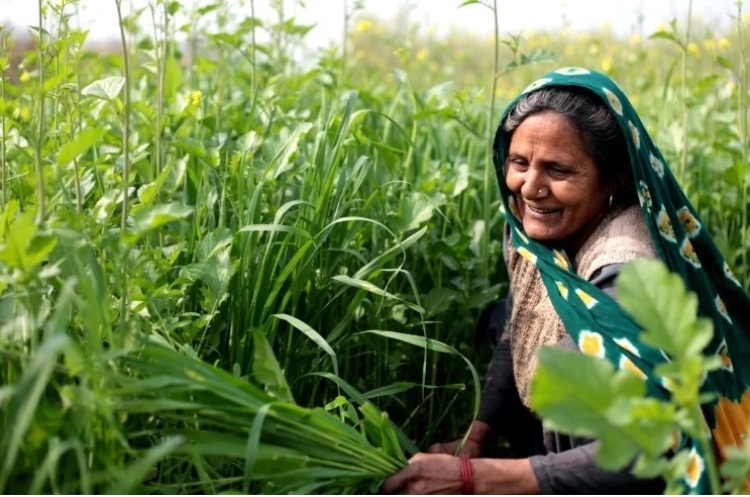 In the heart of rural India, the age-old struggle between staying rooted and migrating for survival continues unabated. The dream of building a fulfilling life within one's own community often fades in the face of economic hardships, leading to a mass exodus from villages to urban centres. But what if the solution lies not in leaving, but in transforming the very landscape of rural India itself?
In the heart of rural India, the age-old struggle between staying rooted and migrating for survival continues unabated. The dream of building a fulfilling life within one's own community often fades in the face of economic hardships, leading to a mass exodus from villages to urban centres. But what if the solution lies not in leaving, but in transforming the very landscape of rural India itself?
Neeraj Ahuja, Associate Director at Transform Rural India (TRI), where he focuses on Bending Markets for Flourishing Localities Practice and leads the Rural Entrepreneurship & Employability Program, explores this transformative idea in his article, "Sustainable Prosperity: How Local Opportunities and Fair Wages Can Curb Migration and Revitalize Rural Economies." He delves into the root causes of rural migration including job scarcity, low wages, and underdeveloped infrastructure, while offering innovative strategies for revitalization.
The article presents a compelling vision for a future where rural communities can thrive without the need for migration. By focusing on place-based development, Ahuja highlights the untapped potential of India's rural regions and invites readers to join him in reimagining a more prosperous and equitable future for all.
To dive deeper into these innovative solutions and learn how local opportunities can reshape rural economies, read the full article here.
Sustainable Prosperity: How Local Opportunities and Fair Wages Can Curb Migration and Revitalize Rural Economies
"I don't want to leave my village, but there is no future here. If you are to do anything in your life, you have to move out of villages," shared a young man from Barwani, Madhya Pradesh during a recent conversation. His words reflect the sentiment of millions in rural Indians who feel compelled to leave their homes not out of choice but necessity. This reality is at the heart of the growing migration patterns in rural regions, where a lack of local opportunities pushes individuals to seek livelihoods elsewhere.
Understanding rural migration and challenges
Rural migration in India is primarily driven by the search for employment opportunities, low wages, and inadequate infrastructure. The Migration in India, 2020-21 report reveals that the overall migration rate stands at 28.9%, with rural areas accounting for 26.5% of this movement. Notably, 42.9% ofmale migration from rural regions is attributed to the pursuit of better employment opportunities or work. On the other hand, according to the State of Rural Youth Employment Report, 2024, 60% of male and 70% of female respondents from rural areas prefer staying close to their villages, even at lower incomes. However, the lack of local job opportunities forces many to migrate, creating a vicious cycle. As skilled workers leave, rural productivity further declines, leading to decreased economic activity. This economic depletion in turn drives more migration, perpetuating a cycle where rural areas lose their workforce and struggle to sustain growth, leaving little choice for those remaining but to seek opportunities elsewhere.
In order to enhance rural livelihoods and reduce poverty, the Indian government has implemented various programs like National Rural Livelihoods Mission, MNREGS, Start-up India, Mudra Yojana, PMEGP, and Vishwakarma Yojna to provide financial assistance and training support to rural communities. These programs have laid the groundwork for rural employment and entrepreneurship, but their impact has been limited by several challenges, including mismatched training programs, centralized training infrastructures, and limited financial access.
Promoting local jobs in rural areas
Rural economies in India face significant challenges due to limited employment opportunities, an overreliance on agriculture, and a lack of diversification in non-farm sectors. The agrarian focus has resulted in seasonal employment, low incomes, and vulnerability to economic shocks, which in turn drives rural-urban migration. To curb this distress migration and revitalize rural economies, it is crucial to create sustainable local jobs by promoting agribusiness, developing the non-farm sector, and encouraging rural entrepreneurship at scale.
1. Rural as Engine of Growth
A key strategy for promoting local jobs is the establishment of Rural Growth Centres, which can serve as hubs of economic activity, diversifying the rural economy beyond agriculture. These centres can promote non-farm activities like agro-processing, digital services, and small manufacturing, providing new employment opportunities. The cluster-based development approach, where rural businesses share infrastructure and resources, can enhance competitiveness and reduce operational costs, enabling rural enterprises to thrive. Successful models like MSME Cluster and SFURTI have demonstrated the benefits of such an approach, which can be scaled further to reduce rural dependency on agriculture.
Furthermore, leveraging public-private partnerships (PPP) is essential to pooling resources, expertise, and investments. A framework for collaboration between local governance institutions, the private sector, and community organizations can bring in the necessary infrastructure and funding to sustain these Rural Growth Centres. This place-based approach not just promotes entrepreneurship but also ensures that local jobs are created in alignment with regional economic strengths, utilizing local skills, cultural heritage, and natural resources.
2. Accessible, Affordable and Customized Services
One of the primary reasons for the lack of rural job creation is the mismatch between the aspirations of rural youth and the local training programs and job opportunities. By focusing on skill development tailored to local industry needs, training programs can equip rural youth with employable skills in high-growth sectors such as agro-processing, renewable energy, tourism, creative industries, IT services, etc.
Further, there is a critical gap of accessible employability and entrepreneurship services in rural areas. Unlocking the potential of rural entrepreneurship is critical to creating sustainable jobs. This requires creating Phygital WOW (World of Work) Hubs—combining physical infrastructure with digital platforms— which can offer counselling, training, mentoring and market linkage support to rural entrepreneurs. These hubs, hosted in local institutions, can provide critical Business Development Services (BDS) such as business planning, financing, and marketing support. Lastly, integrating entrepreneurship education within the rural curriculum, coupled with practical training and mentorship programs, will further ensure that the younger generation is well-prepared to contribute to the local economy.
3. Breaking financial barriers
A significant barrier to rural job creation and entrepreneurship is the lack of affordable and accessible finance. As per the State of the Youth Employment Report – 2024, 90% of men and 50% of women seeking to start small businesses mentioned seed capital as their primary need. However, the reliance on traditional banking institutions, by design, limits the ability of rural entrepreneurs to access timely capital. To overcome this, promoting innovative solutions aroundmicro-credit andlow-interest loans—particularly for women and youth—can provide the financial support necessary to grow rural enterprises.
Further, innovative financial products that share risks, like micro-equity financing, can help micro and small enterprises access working capital without the constraints of conventional lending. By introducing such tailored financial solutions, the growth of rural businesses can be accelerated, leading to more local jobs and economic stability.
4. Strengthening Rural Infrastructure to Boost Employment
Investing in rural infrastructure is crucial for boosting the rural economy and reducing the need for people to migrate to cities for jobs. Affordable housing projects in rural areas not only improve living conditions but also create jobs. By using green construction technologies, these projects not only protect the environment but also offer “green" jobs to rural youth.
Additionally, improving digital infrastructure is key to supporting the growth of online services in rural areas. Reliable internet can open up new job opportunities in fields like IT, e-commerce, and other digital services, helping rural communities participate in the digital economy and reducing their dependence on migration for better livelihoods.
The challenges of rural migration are deeply intertwined with job scarcity, low wages, and poor infrastructure. A holistic approach—focusing on creating local opportunities, providing accessible employability and entrepreneurship services, and investing in infrastructure—can create flourishing localities which the rural communities can call home. The examples above highlight the importance of place-based interventions, which ensure that rural areas are not left behind in the broader push for economic growth. By focusing on local opportunities and skills, rural economies can be revitalized, benefiting not just individual workers but entire communities.




 In the heart of rural India, the age-old struggle between staying rooted and migrating for survival continues unabated. The dream of building a fulfilling life within one's own community often fades in the face of economic hardships, leading to a mass exodus from villages to urban centres. But what if the solution lies not in leaving, but in transforming the very landscape of rural India itself?
In the heart of rural India, the age-old struggle between staying rooted and migrating for survival continues unabated. The dream of building a fulfilling life within one's own community often fades in the face of economic hardships, leading to a mass exodus from villages to urban centres. But what if the solution lies not in leaving, but in transforming the very landscape of rural India itself?












.jpg)




